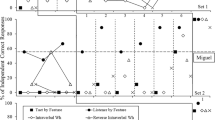Abstract
We evaluated the effects of instructive feedback on the variability of intraverbal responses for two children with autism spectrum disorder. Specifically, we used an adapted alternating treatments design to compare participants’ novel responses and response combinations during an intraverbal category program across conditions with and without instructive feedback. During instructive feedback, secondary targets were presented during the consequence event of the learning trial and consisted of a therapist’s model of response variability. The results showed that participants engaged in more novel response combinations during instructive feedback conditions. We discussed the clinical implications of these results as well as areas for future research.



Similar content being viewed by others
References
American Psychiatric Association. (2013). Diagnostic and statistical manual of mental disorders (5th ed.). Arlington: American Psychiatric Publishing.
Baer, D. M., Peterson, R. F., & Sherman, J. A. (1967). The development of imitation by reinforcing behavioral similarity to a model. Journal of the Experimental Analysis of Behavior, 10, 405–416. doi:10.1901/jeab.1967.10-405.
Carroll, R. A., Joachim, B. T., St. Peter, C. C., & Robinson, N. (2015). A comparison of different error-correction procedures on skill acquisition during discrete-trial instruction. Journal of Applied Behavior Analysis, 48, 1–17. doi:10.1002/jaba.205.
Charlop, M. H., Schreibman, L., & Thibodeau, M. G. (1985). Increasing spontaneous verbal responding in autistic children using a time delay procedure. Journal of Applied Behavior Analysis, 18, 155–166. doi:10.1901/jaba.1985.18-155.
Dunn, L. M., & Dunn, D. M. (2007). Peabody picture vocabulary test manual (4th ed.). Minneapolis: Pearson.
Esch, J. W., Esch, B. E., & Love, J. R. (2009). Increasing vocal variability in children with autism using a lag schedule of reinforcement. The Analysis of Verbal Behavior, 25, 73–78.
Heldt, J., & Schlinger, H. D. (2012). Increased variability in tacting under lag 3 schedule of reinforcement. The Analysis of Verbal Behavior, 28, 131–136.
Higbee, T., Carr, J. E., & Harrison, C. D. (2000). Further evaluation of the multiple-stimulus preference assessment. Research in Developmental Disabilities, 21, 61–73. doi:10.1016/S0891-4222(99)00030-X.
Ingvarsson, E. T., & Hollobaugh, T. (2011). An evaluation of prompting tactics to establish intraverbals in children with autism. Journal of Applied Behavior Analysis, 44, 659–664. doi:10.1901/jaba.2011.44-659.
Ingvarsson, E. T., & Le, D. D. (2011). Further evaluation of prompting tactics for establishing intraverbal responding in children with autism. The Analysis of Verbal Behavior, 27, 75–93.
Kodak, T., Fuchtman, R., & Paden, A. (2012). A comparison of intraverbal training procedures for children with autism. Journal of Applied Behavior Analysis, 45, 155–160. doi:10.901/jaba.2012.45-155.
Lee, R., & Sturmey, P. (2006). The effects of script-fading and a lag-1 schedule on varied social responding in children with autism. Research in Autism Spectrum Disorders, 8, 440–448. doi:10.1016/j.rasd.2014.01.003.
Lee, R., McComas, J. J., & Jawor, J. (2002). The effects of differential and lag reinforcement schedules on varied verbal responding by individuals with autism. Journal of Applied Behavior Analysis, 35, 391–402. doi:10.1901/jaba.2002.35-391.
Loughrey, T. O., Betz, A. M., Majdalany, L. M., & Nicholson, K. (2014). Using instructive feedback to teach category names to children with autism. Journal of Applied Behavior Analysis, 47, 425–430. doi:10.1002/jaba.123.
Reichow, B., & Wolery, M. (2011). Comparison of progressive prompt delay with and without instructive feedback. Journal of Applied Behavior Analysis, 44, 327–340. doi:10.1901/jaba.2011.44-327.
Sindelar, P. T., Rosenberg, M. S., & Wilson, R. J. (1985). An adapted alternating treatments design for instructional research. Education and Treatment of Children, 8, 67–76.
Skinner, B. F. (1957). Verbal behavior. Acton: Copley.
Smith, T. (2001). Discrete trial training in the treatment of autism. Focus on Autism and Other Developmental Disabilities, 16, 86–92. doi:10.1177/108835760101600204.
Sundberg, M. L., & Michael, J. (2001). The value of Skinner’s analysis of verbalbehavior for teaching children with autism. Behavior Modification, 25, 698–724. doi:10.1177/0145445501255003.
Sundberg, M. L., & Partington, J. W. (1999). The need for both discrete trial training and natural environment language training for children with autism. In P. Ghezzi, W. L. Williams, & J. E. Carr (Eds.), Autism: behavior analytic perspectives (pp. 139–156). Reno: Context Press.
Susa, C. L., & Schlinger, H. D. (2012). Using a lag schedule to increase variability of verbal responding in an individual with autism. The Analysis of Verbal Behavior, 28, 125–130.
Vladescu, J. C., & Kodak, T. (2013). Increasing instructional efficiency by presenting additional stimuli in learning trials for children with autism spectrum disorders. Journal of Applied Behavior Analysis, 46, 805–816. doi:10.1002/jaba.70.
Werts, M. G., Wolery, M., Holcombe, A., & Frederick, C. (1993). Effects of instructive feedback related and unrelated to the target behaviors. Exceptionality, 4, 81–95. doi:10.1207/s15327035ex0402_2.
Werts, M. G., Wolery, M., Venn, M. L., Demblowski, D., & Doren, H. (1996). Effects of transition-based teaching with instructive feedback on skill acquisition by children with and without disabilities. Journal of Educational Research, 90, 75–86. doi:10.1080/00220671.1996.9944448.
Wolery, M., Doyle, P. M., Ault, M. J., Gast, D. L., Meyer, S., & Stinson, D. (1991). Effects of presenting incidental information in consequent events on future learning. Journal of Behavioral Education, 1, 79–104. doi:10.1007/BF00956755.
Wolery, M., Holcombe, A., Werts, M. G., & Cipolloni, R. M. (1993a). Effects of simultaneous prompting and instructive feedback. Early Education and Development, 4, 20–31. doi:10.1207/s15566935eed0401_2.
Wolery, M., Werts, M. G., & Holcombe, A. (1993b). Reflections on “effects of instructive feedback related and unrelated to the target behaviors.” Exceptionality, 4, 117–123. doi:10.1207/s15327035ex0402_5.
Acknowledgments
The design and data-collection portions of this study were conducted while both investigators were at the University of Nebraska Medical Center’s Munroe-Meyer Institute. We would like to thank Elizabeth Bullington, Nitasha Dickes, and Joslyn Mintz for their assistance with data collection.
Author information
Authors and Affiliations
Corresponding author
Rights and permissions
About this article
Cite this article
Carroll, R.A., Kodak, T. Using Instructive Feedback to Increase Response Variability During Intraverbal Training for Children with Autism Spectrum Disorder. Analysis Verbal Behav 31, 183–199 (2015). https://doi.org/10.1007/s40616-015-0039-x
Published:
Issue Date:
DOI: https://doi.org/10.1007/s40616-015-0039-x




